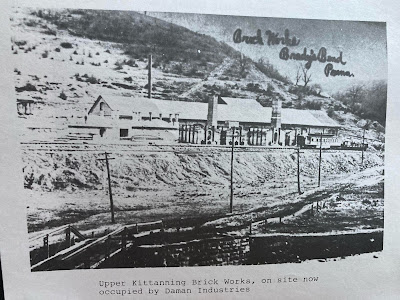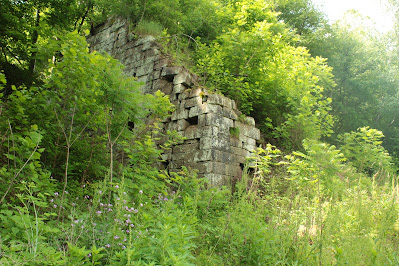In Clarion County, not far from Brady’s Bend, in fact just a few curves up the river were two small towns which owed their existence to the iron furnaces located in them. As is the case with most of the iron furnaces built in Pennsylvania in the 1800’s, after the natural resources were depleted, the industry left and nature reclaimed what was hers. On today’s outing, we were going to see what is left, if anything.
We were going to roam around the area where the Catfish and Sarah Furnaces once stood. There is only speculation as to where they were, no ruins remain. We were going to see if we, the intrepid explorers that we are, could find anything that countless others had overlooked.
Frank Festa, Jeff Parsons and I headed north around 8:30 in the morning. The sky was filled with heavy grey clouds, but the forecasters were promising sunny skies later in the day. The weather didn’t concern us much, at least it wasn’t raining!
Nearing Brady’s Bend, we made a stop in Kaylor. We came to a flat spot in the road where a set of railroad tracks used to cross. Coming out of a valley on one side, they led into a wide area that at one time was filled with tracks. For many years a set of EMD F7s sat here, apparently rusting away. A neighbor who used to work on the railroad told us that they were moved out before the tracks were removed.
The tracks had been taken out decades ago and what few buildings sat here have been torn down. A chain link fence sits there protecting an empty lot. A cement pad is evident but all signs of the tracks have been removed. New gravel has been spread across the yard covering over the grease and oil spills so common to rail yards. A round house once sat here but that was gone also, hidden from our view.
We stopped a mile or two down the road where a brickyard used to sit, the plant was called the Upper Kittanning Brick Company. Like the RR yard, it has long ago disappeared and a new building has been built on the site. Frank is a brick collector and for a while we searched alongside the stream and hillside near the area for any exciting pieces. Stamped bricks are the ones he looks for, proof of where they were manufactured. We found lots of bricks but only one that had anything printing on it, the letters UK B. We took it along with us.
Since we were passing by it, we stopped at the site of the Great Western Iron Company or The Brady’s Bend Works. A large manufacturing plant used to sit here, complete with 4 huge iron furnaces and a rolling mill. The first furnace was built in 1840 and the complex eventually shut down in 1873. The only things remaining are two of the furnaces, both collapsing in on themselves. Even though they are in poor shape, some parts of the sides are still straight, and the corners are still sharp and in line, showing the skill of the workers who built them, so many years ago.
From the overlook on top of the hill above East Brady, we could see the twisting Alleghany River below us and the spot we would be heading towards. A couple miles further up the road we turned onto Sarah Furnace Road. A sign stated that there was NO OUTLET! Two miles into our decent we came to a sharp right-hand turn and a parking lot for the Armstrong Trail. We pulled in, parked and got out to do some searching. This was where the community of Catfish was located.
Erected in 1846, the furnace only produced iron for 10 years, going out of blast in 1856. The small community sat around it providing homes and buildings that supported the furnace. The railroad put its tracks in along the shore of the river and probably eradicated any remains that might have been left. Railroad spurs sat here but there was no sign of them either. Coal mining was very big here and everywhere we looked we found pieces of coal. We saw no houses. Over the hillside from where the tracks sat, now The Armstrong Trail, we found some slag in the dirt. I tend to think the furnace sat above where the slag was found, possibly under or just beyond where the tracks were. We climbed over hillsides, across fallen trees and down into creek beds and found only a few bits of slag.
Just about a 1/2 mile away we drove into the town (?) of Sarah Furnace. Only about 10-15 buildings sit here now including one that was probably the old railroad station. Some look old enough to be from the early 1900’s.
In 1860, about 4 years after the Catfish Furnace shut down, the Sarah Furnace was built. This continued operations until 1867, a mere 7 years. Much like the Catfish site, the railroad had multiple lines coming through the area. The brush was even thicker here, almost impenetrable.
Frank had done lots of research using satellite and aerial pictures. He had points along with GPS positions that could possibly be the location of the furnace. We drove down a dirt road only to be blocked by a wide mud puddle, backing up was the only option. We searched around as much as we could but the growth was so thick we couldn’t even see what was10 feet away from us.
We left the community of Sarah Furnace without finding anything. A search would need to be done in the winter after the leaves had all fallen. We drove further up the "NO OUTLET" road, passing fields and woods, at times the road was just rocks and dirt. We finally returned to rough pavement and then rt.68, a mile away from where we turned in. NO OUTLT, ha!
Other than some slag, an old, rusted spike and a large Black Rat Snake, we didn’t find much of interest, but we still had a good trip! We really weren’t expecting to find anything but we still enjoyed the search! The skies had cleared and we continuously drove through patches of sweet smelling flowers. I will say this, after scrambling around in the woods, streams and fields in 80 degree weather, I was ready for the shower that waited for me at home and BOY, did it feel good!














1 comment:
As always another great adventure!👍
Post a Comment